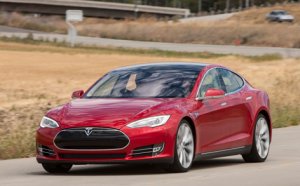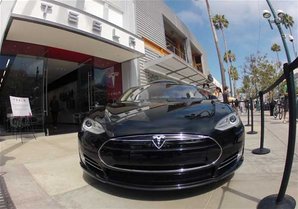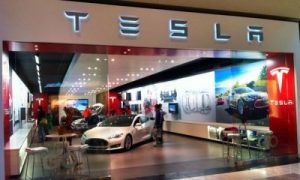by Jon LeSage, editor and publisher, Green Auto Market
Here’s my take on the 10 most significant and interesting occurrences during the past week…….
 Plug-in sales surge: Tesla led August U.S. plug-in sales performance in August, taking a third of the sales with the Model S and Model X. With about 3,200 units sold, the Model S doubled its sales over August 2015. The Chevrolet Volt had another good month, up over 50% in sales over last year while the Nissan Leaf continued its sales decline. Overall sales of all-electric and plug-in hybrid electric vehicles were up 66% over a year ago, according to HybridCar.com’s Dashboard. Hybrid sales were down 14.4% from last year, with the Ford Fusion Hybrid the only hybrid model in the top 10 seeing an increase over last year. Its hybrid sales were up 23% over a year ago, and the Fusion Energi plug-in hybrid sales were up 6% over the previous month and nearly 50% over August 2015.
Plug-in sales surge: Tesla led August U.S. plug-in sales performance in August, taking a third of the sales with the Model S and Model X. With about 3,200 units sold, the Model S doubled its sales over August 2015. The Chevrolet Volt had another good month, up over 50% in sales over last year while the Nissan Leaf continued its sales decline. Overall sales of all-electric and plug-in hybrid electric vehicles were up 66% over a year ago, according to HybridCar.com’s Dashboard. Hybrid sales were down 14.4% from last year, with the Ford Fusion Hybrid the only hybrid model in the top 10 seeing an increase over last year. Its hybrid sales were up 23% over a year ago, and the Fusion Energi plug-in hybrid sales were up 6% over the previous month and nearly 50% over August 2015.- Google takes on Uber and Lyft: Google is testing out a carpooling service in San Francisco designed to compete directly with ridesharing services offered by Uber and Lyft. Since May, Google has been helping employees of major companies carpool to work with drivers sharing their cars with riders going to and from work. The carpool service uses the Waze navigation mobile app; Waze is a subsidiary of Google. Waze users share information with each other about traffic conditions, accidents, and police patrol cars. Riders are being charged at most 54 cents a mile, which is cheaper than Uber, Lyft, and taxi rides. Google and Waze started testing out carpooling last year in Israel, where Waze was founded.
- BYD performance: BYD reportedly sold 53,380 plug-in vehicles in the first half of this year, with Nissan coming in at second with 34,362 and Tesla following closely behind with 33,620. Chinese automaker BYD reported doubling its PEV sales in the first half of this year, and seeing profits going up 400% in the first half of this year compared to the same period the year before. There have been reports that the company is making plans to bring one or more models to the US market in the not too distant future.
- Daimler rolling out 6 to 9 new EV models: Daimler is said to be designing six, and as many as nine, electric cars to better compete in the luxury EV space with Tesla and Audi. A growing political backlash from the Volkswagen “dirty diesel” scandal has driven Daimler’s strategy, along with recent advancements in battery technology. Daimler is scheduled to unveil a new electric car model at the Paris motor show in late September. Will it be an SUV or a sedan?
- California settlement: Volkswagen will pay $86 million to California in the diesel emissions scandal, which is where the largest share of the almost 600,000 cars on U.S. roads rigged to cheat tests were sold. The settlement will help pay for research grants, consumer protection programs, and the cost of the investigation by the California Attorney General’s office. The deal also prohibits VW and Porsche from advertising, selling, leasing or distributing in California any vehicles containing the so-called defeat devices used to cheat pollution tests. The automaker won final approval from the federal judge overseeing hundreds of lawsuits in the U.S.
- Mitsubishi scandal widens: Mitsubishi’s headquarters and Nagoya plant were raided by government officials last week, further complicating the Japanese automaker’s attempts to resolve the mileage manipulation scandal that increased the number of vehicles involved by eight. Mitsubishi has said it used unapproved methods to calculate mileage for 25 years. “We want to thoroughly investigate the circumstances that led to this situation,” said Japan’s Transport Minister Keiichi Ishii.
- Tesla rules Hong Kong: German automakers would like the city of Hong Kong to allow plug-in hybrid electric vehicles in its EV sales numbers, and to change incentives that only all-electric vehicles get to have. For now, only all-electric vehicles are counted, which has helped Tesla Motors gain 80 percent share of that market. Plug-in hybrids aren’t allowed to tap into the 100% waiver on first-registration taxes, which all-electric vehicles are granted. Those numbers can be pretty steep in the market, allowing for a price advantage all-electric vehicles get to enjoy.
- Electrifying trucks: Electrification of medium- and heavy-duty trucks can be one of the best moves fleets and transportation companies can make for cost reduction, even during this time of stable gasoline and diesel prices. Roger Bedell, former CEO and founder of Opbrid Fast Charge, a company that provides high-power bus-charging stations, did a cost analysis for Trucks.com. “The key is to look for situations in which fuel usage is the highest — for example, running big rigs at highway speeds for long distances. Although giant trucks are far from the easiest vehicles to electrify, they have the most potential profit possibilities for electrification,” according to Bedell.
- How to compete with Tesla: German luxury carmakers have been struggling to deal with a big question Tesla Motors has raised – how to make high performance luxury electric cars while also producing a profit. They’re in a different organizational culture lacking the kind of internal management support needed to be strong in the market. Investors have been allowing Tesla to lose money. “Part of it is a cultural issue,” said a Mercedes-Benz official who asked to remain anonymous. “You can’t compare a 130-year-old company shaped by German engineering ingenuity with a startup from Silicon Valley. It’s a different approach.”
- California HOV stickers: California took no action last week on Assembly Bill 1964, which would extend the driving perk beyond 2019 or allow more green stickers above the currently capped 85,000 limit. Legislators don’t know if the bill will be reintroduced in the next legislative session. There are now 6,500 drivers on a waiting list for the green decals. Plug In America has been opposing AB 1964, that supported plug-in hybrid green stickers but limited purchase incentives on battery electric vehicles.


